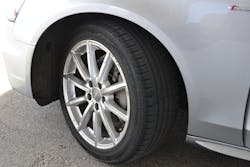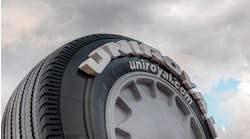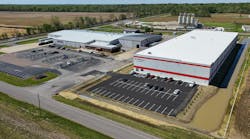Winter tires may have brought Nokian Tyres plc to North America, but they aren’t enough to pave the path to the brand’s growth here.
The tire maker knew it needed to invest in all-season products. First came the eNtyre and Rotiiva lines, and up next is an all-season ultra-high performance tire, the zLine.
“We have a good base of all-season products that we can build on,” says Steve Bourassa, Nokian’s product director for North America. “Nokian Tyres wants to continue to grow.”
And he says the company knew it couldn’t rely on the market to create its growth opportunity. U.S. tire shipments have increased by about 7 million tires since 2000, and the market has been just as flat in Canada. “What has changed has been the product mix within that market,” Bourassa says. “Those HP and UHP segments are our opportunities for growth.”
He points to statistics and projections from the Rubber Manufacturers Association (RMA). In 2000 RMA members counted UHP tires as 3.5% of the replacement passenger tire market, and high performance tires represented 8.7%. By 2018 the two performance segments will account for 40% of the passenger tire market.
And that’s where the Nokian zLine A/S line enters the picture. With sizes for both passenger cars and SUVs, the zLine is W-rated and available for order in 31 sizes for wheels 16 to 20 inches. Of the 31 sizes, all but the two smallest tires are designed to haul extra loads. Consumer purchases are set to begin in January 2017.
Handling, wear and comfort
The zLine features a stiff outer shoulder and contoured groove corners that provide support on wet and slushy roads, even while cornering and making lane changes. Three-dimensional siping binds the tread blocks together for better handling, and cooling technology removes the heat from the hottest parts of the tire, which also improves handling and durability.
A new rubber compound, the Dynamic Traction Boost Tread Compound, was specially tailored for use at higher speeds. Nokian says it improves wet grip and saves fuel, and also stands up against the stress of rough asphalt. The full silica compound provides wet grip no matter the weather, while the tire’s longitudinal and transversal grooves are designed to flush water and slush from between the road’s and tire’s surfaces.
The Comfort Base Compound underneath the tread softens the impacts of driving, and gives the tire a comfortable feel even on rough roads. A Clinch Rubber Compound in the bead area is designed to minimize vibrations from within the tire, and a special groove design targets both interior tire noise and the external rolling noise of the vehicle. But those soft touches are combined with a high tensile steel belt structure which makes the tire’s structure hard, but light. It helps with handling and better mileage, and also is a stronger barrier against cuts caused by curbs, the company says.
Matti Morri, technical customer service manager for Nokian, says the company tested the tire’s tough construction with a water test. It filled a 225/40R18 XL tire with water and cranked up the pressure. The tire didn’t break until it reached 372 psi, and even then, it broke only at the bead.
The passenger and SUV tires are identical, except the tread compound of the SUV tire is even stiffer than the passenger car model. The tougher compound improves handling, and Aramid sidewall technology improves the tire’s service life because it helps reduce sidewall damage. The SUV tire will be available in three extra-load sizes: 255/55R18 109W, 255/50R19 107W and 235/55R19 105W.
Tommi Heinonen, president of Nokian Tyres North America, acknowledges it will take some time for the company to increase its brand awareness in the U.S. “It’s a long run. It’s not going to happen overnight.” But he says Nokian is “actively researching new markets” and working to fill in the “white spots” on the company’s distribution map. “There are a lot of places where Nokian is not available at all.”
But that’s also something that should work in favor of tire dealers who sell the brand, Heinonen says. “It’s a premium tire. It’s something that’s not yet available on every corner. It’s easier for a dealer to make a profit when it’s not available on every corner.”



